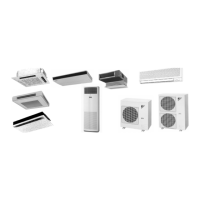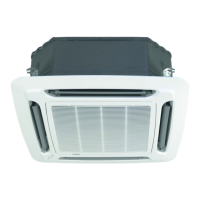2
1. Select an installation site where the following conditions
are fulfilled and that meets your customer’s approval.
• Where optimum air distribution can be ensured.
• Where nothing blocks air passage.
• Where condensate water can be properly drained.
• Where the false ceiling is not noticeably on an incline.
• Where sufficient clearance for maintenance and service
can be ensured.
• Where piping between indoor and outdoor units is possible
within the allowable limit. (Refer to the installation manual
of the outdoor unit.)
• Keep indoor unit, outdoor unit, power supply wiring and
transmission wiring at least 1 meter away from televisions
and radios. This is to prevent image interference and noise
in those electrical appliances.
(Noise may be generated depending on the conditions
under which the electric wave is generated, even if 1 meter
is kept.)
2. Ceiling height
This indoor unit may installed on ceilings up to 3.5m in height
(for 80~125 units: 4.2m). However, it becomes necessary to
make field settings using the remote controller when installing
the unit at a height over 2.7m (for 80~125 units: 3.2 m).
To avoid accidental touching, it is recommended to install the
unit higher than 2.5m.
Refer to the chapter "Field setting" and to the decoration
panel installation manual.
3. Air flow directions
Select the air flow directions best suited to the room and point
of installation. (For air discharge in 2 or 3 directions, it is
necessary to make field settings by means of the remote
controller and to close the air outlet(s). Refer to the installation
manual of the optional blocking pad kit and to the chapter
"Field setting".
see figure 1 (
: air flow direction)
1 Air discharge in 4 directions
2 Air discharge in 3 directions
3 Air discharge in 2 directions
4. Use suspension bolts for installation. Check whether the
ceiling is strong enough to support the weight of the
indoor unit. If there is a risk, reinforce the ceiling before
installing the unit.
(The installation pitch is marked on the paper pattern for
installation. Refer to it to check for points requiring reinforcing.)
Space required for installation see figure 2 (
: air flow direc-
tion)
1 Air discharge
2 Air inlet
NOTE
• Leave 200mm or more space where marked with *, on sides
where the air outlet is closed.
Model H
FH(Y)C(P)35~71 ≥240
FHYC(P)100•125 ≥298
Notes to the installer
• Read this manual carefully to ensure correct installation. Be
sure to instruct the customer how to properly operate the
system and show him/her the enclosed operation manual.
• Explain to the customer what system is installed on the site.
Be sure to fill out the appropriate installation specifications in
the chapter "What to do before operation" of the outdoor unit
operation manual.
SELECTING INSTALLATION SITE
When the conditions in the ceiling are exceeding 30°C and a
relative humidity of 80%, or when fresh air is inducted into the
ceiling, an additional insulation is required (minimum 10mm
thickness, polyethylene foam).
For this unit you can select different air flow directions. It is
necessary to purchase an optional blocking pad kit to discharge
the air in 2 or 3 directions.
❑
❑
❑
❑
❑
❑
❑
❑
❑
❑
For the following items, take special care during
construction and check after installation is finished
Tick when checked
Is the indoor unit fixed firmly?
The unit may drop, vibrate or make noise.
Is the gas leak test finished?
It may result in insufficient cooling.
Is the unit fully insulated?
Condensate water may drip.
Does drainage flow smoothly?
Condensate water may drip.
Does the power supply voltage correspond to that shown on
the name plate?
The unit may malfunction or components may burn out.
Are wiring and piping correct?
The unit may malfunction or components may burn out.
Is the unit safely grounded?
Dangerous at electric leakage.
Is the wiring size according to specifications?
The unit may malfunction or components may burn out.
Is nothing blocking the air outlet or inlet of either the
indoor or outdoor units?
It may result in insufficient cooling.
Are refrigerant piping length and additional refrigerant charge
noted down?
The refrigerant charge in the system might not be clear.

